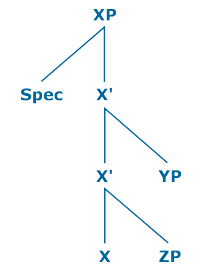Implications

X-bar theory aims at bringing out the common properties of syntactic constituents such as NP, VP, etc. by proposing that they are all organized according to the same scheme, which is assumed to be part of the grammar of every speaker.
Put differently, what speakers have as part of their cognitive system is a general format for phrase structure rules which are independent of any syntactic category (N, A, V, etc.). Instead of rules for particular types of phrases, the grammar contains the general scheme below:
Specifier rule:
XP ⇨ (Spec) X' or
XP ⇨ X' (Spec)
(Adjunct rule:
X' ⇨ X' (YP)
or
X' ⇨ (YP) X'
Complement rule:
X' ⇨ X (ZP) or
X'⇨ (ZP) X
Having a single uniform scheme that determines the makeup of constituents has important implications for the organization of the grammar. In effect, it allows constituent structure to be generated based on a general parameterized format plus word-related information provided by the lexicon, rendering traditional phrase structure rules redundant. This is not only attractive from a theory-internal point of view but also increases the explanatory power of the theory because it helps to explain the ease and speed of language acquisition.
